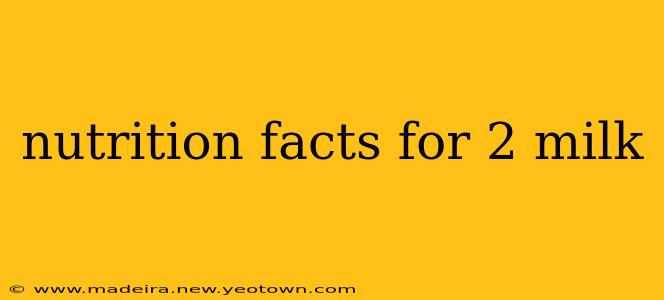Decoding the Dairy Dilemma: A Deep Dive into the Nutrition Facts of 2% Milk
Let's be honest, milk is a staple in many households, sparking countless debates around its nutritional value. But what exactly is in that glass of 2% milk? And how does it compare to other milk options? This isn't just about calories; we're exploring the complete nutritional profile, answering those nagging questions you might have about this everyday beverage. Our journey starts with understanding the basics and then delves into the specifics of what makes 2% milk tick.
Imagine this: You’re standing in the dairy aisle, faced with a sea of milk cartons – skim, 1%, 2%, whole… the choices can feel overwhelming. You reach for the familiar 2% option, but what exactly are you getting? Let's unpack the nutritional powerhouse that is a typical 8-ounce serving of 2% milk.
A Typical Nutritional Profile of 8 oz (240ml) of 2% Milk:
This information is approximate and can vary slightly depending on the brand and processing. Always check the individual product label for the most accurate data.
- Calories: Approximately 120-130
- Fat: Around 5 grams (mostly saturated)
- Protein: Roughly 8 grams
- Carbohydrates: Approximately 12 grams (mostly lactose)
- Calcium: A significant source, typically around 30% of the recommended daily value (DV).
- Vitamin D: Often fortified, contributing to bone health.
- Potassium: An essential electrolyte, beneficial for fluid balance.
- Riboflavin (Vitamin B2): Important for energy metabolism.
What are the key nutrients in 2% milk?
2% milk offers a balanced blend of essential nutrients. Its most notable contributions are:
- Calcium: Crucial for strong bones and teeth, playing a vital role in preventing osteoporosis. This makes 2% milk a great choice for growing children and adults aiming to maintain bone density.
- Protein: Essential for building and repairing tissues, vital for muscle growth and overall bodily function. The protein in milk is considered a complete protein, containing all nine essential amino acids.
- Vitamin D: Often added during processing, Vitamin D is critical for calcium absorption, boosting the overall benefits of the calcium content. It also supports immune function and overall health.
Is 2% milk good for weight loss?
This is a frequently asked question, and the answer is nuanced. While 2% milk contains fewer calories and fat than whole milk, it's still not a zero-calorie beverage. Its moderate fat content can contribute to feelings of fullness, potentially aiding in weight management. However, moderation is key. Incorporating it into a balanced diet and exercise routine will yield better results than relying on it as a weight-loss miracle.
How does 2% milk compare to other milk types?
The main difference lies in the fat content:
- Skim milk (fat-free): Lowest in calories and fat, but may lack some of the creaminess and flavor.
- 1% milk (low-fat): A middle ground between 2% and skim milk, offering a slightly richer taste.
- Whole milk: Highest in fat and calories, offering the richest flavor and texture.
Choosing the right type of milk depends on individual dietary needs and preferences. Consider your calorie goals, dietary restrictions, and personal taste when making your selection.
What are the potential downsides of drinking 2% milk?
While generally healthy, some individuals may experience:
- Lactose intolerance: Lactose, the sugar in milk, can cause digestive discomfort in those lacking the enzyme lactase.
- Saturated fat content: Although lower than whole milk, 2% milk still contains saturated fat, which should be consumed in moderation as part of a balanced diet. Those with high cholesterol should be mindful of their intake.
Ultimately, 2% milk, consumed as part of a balanced and varied diet, offers a valuable source of essential nutrients. Remember to always read the nutrition label and choose the option that best fits your individual health goals and lifestyle. And remember, consulting a registered dietitian or healthcare professional can provide personalized dietary advice based on your specific needs.

